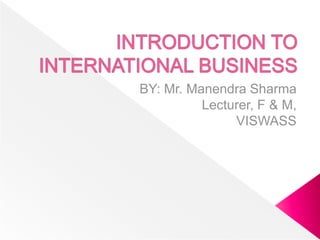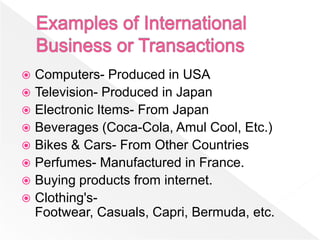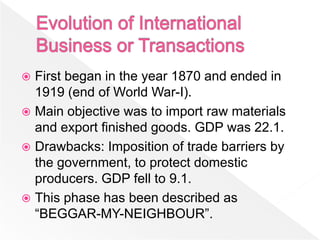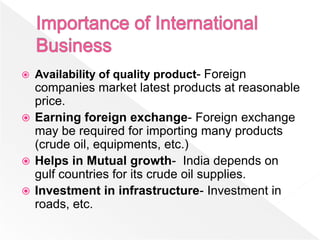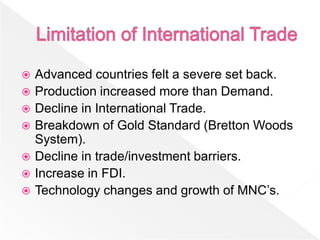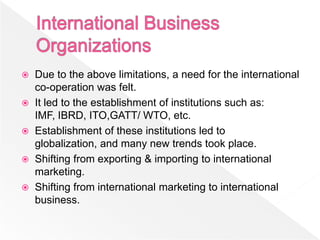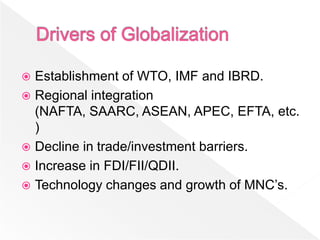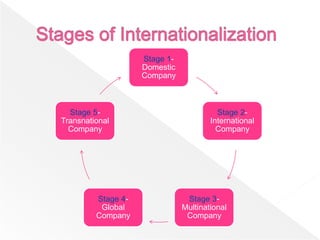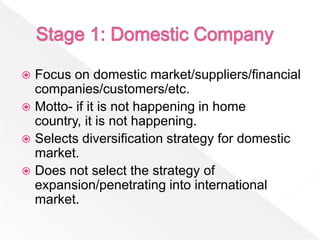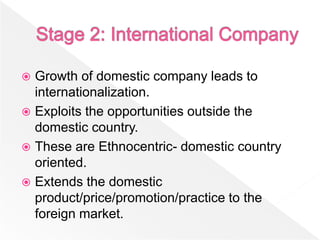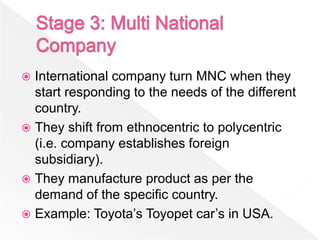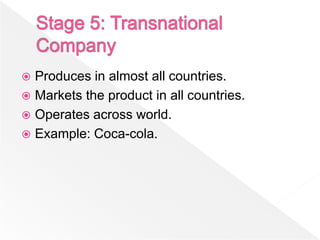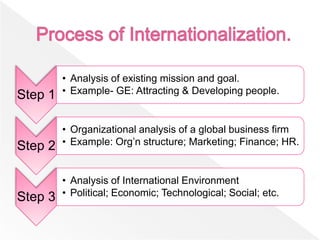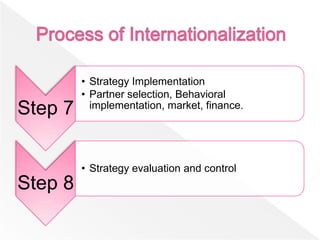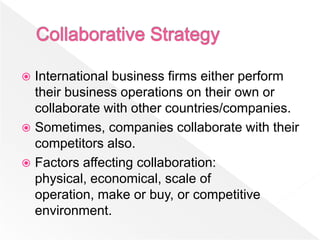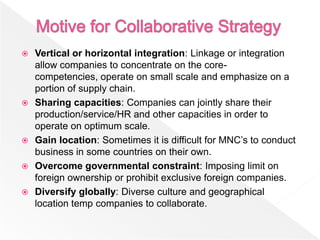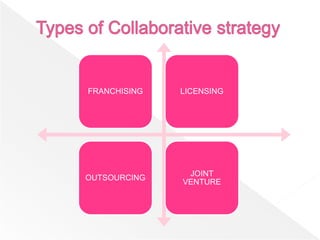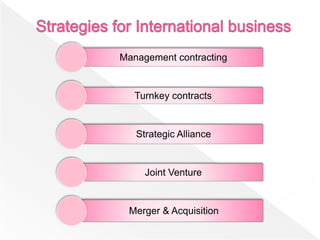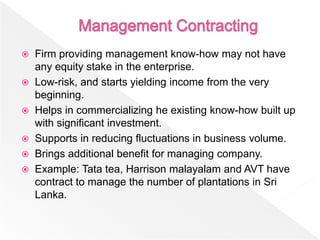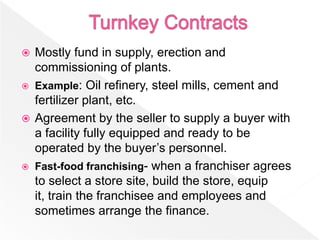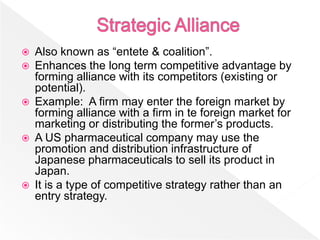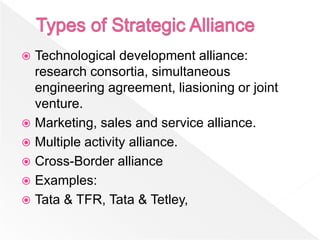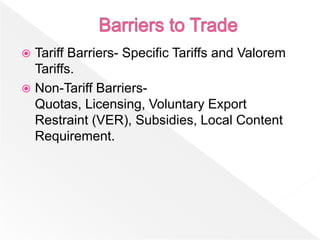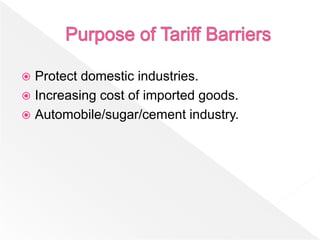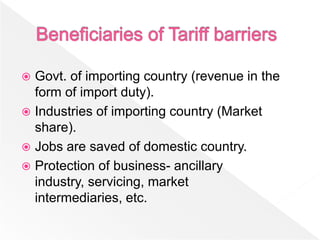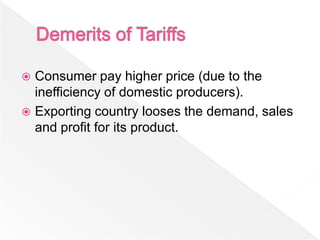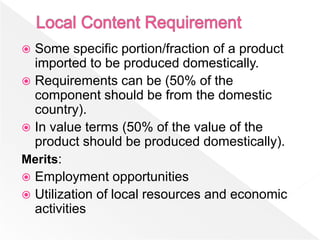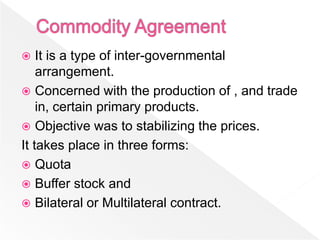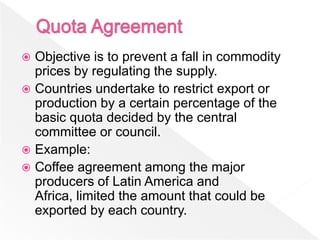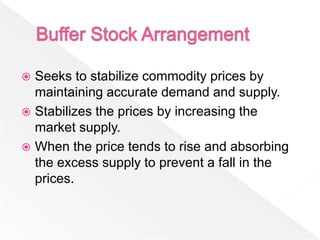Unit 1
- 2. ’é× Computers- Produced in USA ’é× Television- Produced in Japan ’é× Electronic Items- From Japan ’é× Beverages (Coca-Cola, Amul Cool, Etc.) ’é× Bikes & Cars- From Other Countries ’é× Perfumes- Manufactured in France. ’é× Buying products from internet. ’é× Clothing's- Footwear, Casuals, Capri, Bermuda, etc.
- 3. ’é× First began in the year 1870 and ended in 1919 (end of World War-I). ’é× Main objective was to import raw materials and export finished goods. GDP was 22.1. ’é× Drawbacks: Imposition of trade barriers by the government, to protect domestic producers. GDP fell to 9.1. ’é× This phase has been described as ŌĆ£BEGGAR-MY-NEIGHBOURŌĆØ.
- 4. ’é× Growth Strategy- Leads to geographical expansion. ’é× Managing Product life-cycle- Shifting of the market. ’é× Technology Advantages- Core competencies. ’é× New business opportunity- entering new market. ’é× Proper use of resources- proper utilization of natural resources of countries (material, labor, etc.) ’é¢ Conti.
- 5. ’é× Availability of quality product- Foreign companies market latest products at reasonable price. ’é× Earning foreign exchange- Foreign exchange may be required for importing many products (crude oil, equipments, etc.) ’é× Helps in Mutual growth- India depends on gulf countries for its crude oil supplies. ’é× Investment in infrastructure- Investment in roads, etc.
- 6. ’é× Advanced countries felt a severe set back. ’é× Production increased more than Demand. ’é× Decline in International Trade. ’é× Breakdown of Gold Standard (Bretton Woods System). ’é× Decline in trade/investment barriers. ’é× Increase in FDI. ’é× Technology changes and growth of MNCŌĆÖs.
- 7. ’é× Due to the above limitations, a need for the international co-operation was felt. ’é× It led to the establishment of institutions such as: IMF, IBRD, ITO,GATT/ WTO, etc. ’é× Establishment of these institutions led to globalization, and many new trends took place. ’é× Shifting from exporting & importing to international marketing. ’é× Shifting from international marketing to international business.
- 8. ’é× Establishment of WTO, IMF and IBRD. ’é× Regional integration (NAFTA, SAARC, ASEAN, APEC, EFTA, etc. ) ’é× Decline in trade/investment barriers. ’é× Increase in FDI/FII/QDII. ’é× Technology changes and growth of MNCŌĆÖs.
- 9. Stage 1- Domestic Company Stage 5- Stage 2- Transnational International Company Company Stage 4- Stage 3- Global Multinational Company Company
- 10. ’é× Focus on domestic market/suppliers/financial companies/customers/etc. ’é× Motto- if it is not happening in home country, it is not happening. ’é× Selects diversification strategy for domestic market. ’é× Does not select the strategy of expansion/penetrating into international market.
- 11. ’é× Growth of domestic company leads to internationalization. ’é× Exploits the opportunities outside the domestic country. ’é× These are Ethnocentric- domestic country oriented. ’é× Extends the domestic product/price/promotion/practice to the foreign market.
- 12. ’é× International company turn MNC when they start responding to the needs of the different country. ’é× They shift from ethnocentric to polycentric (i.e. company establishes foreign subsidiary). ’é× They manufacture product as per the demand of the specific country. ’é× Example: ToyotaŌĆÖs Toyopet carŌĆÖs in USA.
- 13. ’é× Produces in a home/single country. ’é× Markets the same product globally. ’é× They have global marketing strategy. ’é× Produces for the global market but focuses domestically. ’é× Example: Harley Davidson- Produced in USA, Focused globally. ’é× Dr. ReddyŌĆÖs Lab- Produces in India but market globally.
- 14. ’é× Produces in almost all countries. ’é× Markets the product in all countries. ’é× Operates across world. ’é× Example: Coca-cola.
- 15. ŌĆó Analysis of existing mission and goal. Step 1 ŌĆó Example- GE: Attracting & Developing people. ŌĆó Organizational analysis of a global business firm Step 2 ŌĆó Example: OrgŌĆÖn structure; Marketing; Finance; HR. ŌĆó Analysis of International Environment Step 3 ŌĆó Political; Economic; Technological; Social; etc.
- 16. ŌĆó Formulation of alternative corporate level strategy ŌĆó Stability; Growth; Retrenchment; Combination; Step 4 Turnaround ŌĆó Formulation of alternative business level strategy ŌĆó Low cost leadership; Niche strategy; Differentiation. Step 5 ŌĆó Selection of best among the alternative strategies ŌĆó BCG matrix; Directional policy; 9 cell matrix. Step 6
- 17. ŌĆó Strategy Implementation ŌĆó Partner selection, Behavioral Step 7 implementation, market, finance. ŌĆó Strategy evaluation and control Step 8
- 18. ’é× International business firms either perform their business operations on their own or collaborate with other countries/companies. ’é× Sometimes, companies collaborate with their competitors also. ’é× Factors affecting collaboration: physical, economical, scale of operation, make or buy, or competitive environment.
- 19. ’é× Spread and reduced cost- reducing the start up cost and reducing the time by outsourcing. ’é× Specialize in core competency: companies perform the activities concerning core competencies most efficiently compared to other activities. ’é× Avoid or counter competencies: Some market are not large enough to accommodate competitors. ’é× Minimize exposure in risky environment: Political/economic and security factors create risky business environment in different countries.
- 20. ’é× Vertical or horizontal integration: Linkage or integration allow companies to concentrate on the core- competencies, operate on small scale and emphasize on a portion of supply chain. ’é× Sharing capacities: Companies can jointly share their production/service/HR and other capacities in order to operate on optimum scale. ’é× Gain location: Sometimes it is difficult for MNCŌĆÖs to conduct business in some countries on their own. ’é× Overcome governmental constraint: Imposing limit on foreign ownership or prohibit exclusive foreign companies. ’é× Diversify globally: Diverse culture and geographical location temp companies to collaborate.
- 21. FRANCHISING LICENSING JOINT OUTSOURCING VENTURE
- 22. Management contracting Turnkey contracts Strategic Alliance Joint Venture Merger & Acquisition
- 23. ’é× Firm providing management know-how may not have any equity stake in the enterprise. ’é× Low-risk, and starts yielding income from the very beginning. ’é× Helps in commercializing he existing know-how built up with significant investment. ’é× Supports in reducing fluctuations in business volume. ’é× Brings additional benefit for managing company. ’é× Example: Tata tea, Harrison malayalam and AVT have contract to manage the number of plantations in Sri Lanka.
- 24. ’é× Mostly fund in supply, erection and commissioning of plants. ’é× Example: Oil refinery, steel mills, cement and fertilizer plant, etc. ’é× Agreement by the seller to supply a buyer with a facility fully equipped and ready to be operated by the buyerŌĆÖs personnel. ’é× Fast-food franchising- when a franchiser agrees to select a store site, build the store, equip it, train the franchisee and employees and sometimes arrange the finance.
- 25. ’é× Also known as ŌĆ£entete & coalitionŌĆØ. ’é× Enhances the long term competitive advantage by forming alliance with its competitors (existing or potential). ’é× Example: A firm may enter the foreign market by forming alliance with a firm in te foreign market for marketing or distributing the formerŌĆÖs products. ’é× A US pharmaceutical company may use the promotion and distribution infrastructure of Japanese pharmaceuticals to sell its product in Japan. ’é× It is a type of competitive strategy rather than an entry strategy.
- 26. ’é× Technological development alliance: research consortia, simultaneous engineering agreement, liasioning or joint venture. ’é× Marketing, sales and service alliance. ’é× Multiple activity alliance. ’é× Cross-Border alliance ’é× Examples: ’é× Tata & TFR, Tata & Tetley,
- 29. ’é× Tariff Barriers- Specific Tariffs and Valorem Tariffs. ’é× Non-Tariff Barriers- Quotas, Licensing, Voluntary Export Restraint (VER), Subsidies, Local Content Requirement.
- 30. ’é× Tariff is the tax imposed on imports. ’é× Specific tariff- it refers to a fixed charge levied on the units of the product imported. ’é× Example: Rs. 1000/- levied on each T.V. imported. ’é× Ad-Valorem tariff- Tariff levied as a proportion of the value of the imported goods (30% on the Total value).
- 31. ’é× Protect domestic industries. ’é× Increasing cost of imported goods. ’é× Automobile/sugar/cement industry.
- 32. ’é× Govt. of importing country (revenue in the form of import duty). ’é× Industries of importing country (Market share). ’é× Jobs are saved of domestic country. ’é× Protection of business- ancillary industry, servicing, market intermediaries, etc.
- 33. ’é× Consumer pay higher price (due to the inefficiency of domestic producers). ’é× Exporting country looses the demand, sales and profit for its product.
- 34. ’é× Motive is to encourage domestic production and to protect domestic producers from foreign competitors. ’é× Govt. pays to domestic producers by reducing their operation cost. ’é× Forms of subsidies- cash grants, loan and advances, tax holidays, govt. procurement of output at a higher rate, equity participation and supply of input at lower prices.
- 35. Merits: ’é× International competitiveness of domestic industry. ’é× Provide large scale economies. ’é× Low cost production. ’é× Early entry to foreign market. ’é× First mover advantage. Demerits: ’é× Protect inefficiency & lethargy of the domestic firms ’é× Do not enhance international competitiveness.
- 36. ’é× Direct restriction on quantity of goods imported. ’é× License are issued to certain firms and individuals. ’é× License are issued for importing certain quantity of goods. ’é× Example: Car, Bikes, Milk, etc. Merits ’é× Protect domestic produces from foreign competition.
- 37. ’é× Opposite form of import quotas. ’é× It is a quota on exports of the domestic firms, imposed by the exporting country. ’é× Imposed on the request of the imorting country. Merits: ’é× Its violation leads to imposition of tariff. ’é× Protect from foreign competitors. ’é× Makes domestic goods cheap.
- 38. ’é× Some specific portion/fraction of a product imported to be produced domestically. ’é× Requirements can be (50% of the component should be from the domestic country). ’é× In value terms (50% of the value of the product should be produced domestically). Merits: ’é× Employment opportunities ’é× Utilization of local resources and economic activities
- 39. ’é× It is a type of inter-governmental arrangement. ’é× Concerned with the production of , and trade in, certain primary products. ’é× Objective was to stabilizing the prices. It takes place in three forms: ’é× Quota ’é× Buffer stock and ’é× Bilateral or Multilateral contract.
- 40. ’é× Objective is to prevent a fall in commodity prices by regulating the supply. ’é× Countries undertake to restrict export or production by a certain percentage of the basic quota decided by the central committee or council. ’é× Example: ’é× Coffee agreement among the major producers of Latin America and Africa, limited the amount that could be exported by each country.
- 41. ’é× Seeks to stabilize commodity prices by maintaining accurate demand and supply. ’é× Stabilizes the prices by increasing the market supply. ’é× When the price tends to rise and absorbing the excess supply to prevent a fall in the prices.
- 42. Bilateral- ’é× Purchase & sale certain quantities of a commodity at agreed prices (between major importer & exporter). ’é× Upper & lower prices are specified. ’é× If the market price remain within this limit, agreement becomes inoperative.
Editor's Notes
- #9: WTO: World Trade Organization; IMF- International Monetary Fund; IBRD- International Bank For Reconstruction And Development; NAFTA- North American Free Trade Agreement; SAARC- South Asian Association For Regional Cooperation; ASEAN- Association Of South East Asian Nation; APEC- Asia Pacific Economic Co-operation; EFTA- European Free Trade Association; FDI- Foreign Direct Investment; FII- Foreign Institutional Investments; QDII- Qualified Domestic Institutional Investment.

